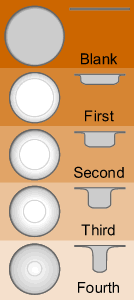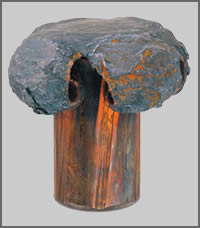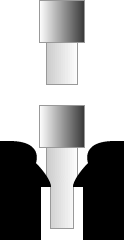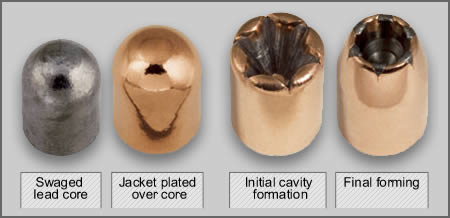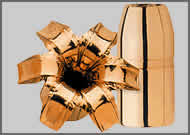Home | Glossary | Resources | Help | Contact Us | Course Map
Archival Notice
This is an archive page that is no longer being updated. It may contain outdated information and links may no longer function as originally intended.
Cup and Draw Operation
Jackets are traditionally produced in cup and draw operations. A shallow cup is formed from a sheet of metal in a cupping press. Dies and punches in the press blank out a disk of the sheet metal and simultaneously form it into a shallow cup. The basic requirements for cups are concentric wall thickness and relatively even tops. The jacket is ultimately trimmed to meet specifications.
A jacket that is not much taller than it is wide (some handgun bullets) can often be used directly from the cupping press if the initial sheet materials thickness is close to the desired jacket thickness. For rifle bullets where the jacket can be two or more times the diameter of the bullet in length, the cup must receive additional processing. This is performed by the draw operation.
In metalworking, drawing a part refers to stretching it under controlled conditions, while reducing the diameter. The control is provided by a die and punch set that maintains constant contact with the jacket walls, ensuring equal stresses at all points on the bullet and controlling concentricity. The draw operation targets the sidewalls of the cup. The resulting part looks like a metal test tube, with a rounded base.
In drawing, several dies may be used in conjunction with one punch. This progressive draw tooling is known as a die stack. The tooling designer must consider the reduction in wall thickness and diameter that the stack must produce. All the dies and the punch must make full contact with the jacket so that no unworked metal remains when the part exits the die stack.
A benefit of drawing for hunting bullets is controlled expansion. Drawing elongates metal grains parallel to the long axis of the jacket. This forms natural parting lines, allowing the jacket to peel back on itself upon impact. Elongation is more prevalent toward the open end and less toward the closed base; the peeling starts quickly and then slows.
Advantages of controlled expansion:
- Bullet maintains integrity after impact.
- Bullet tends to remain in target.
- Energy dissipates more quickly on target.
Bullet Features
Some bullet features cannot be produced during final forming, such as fluted or segmented edges that aid the expansion of hunting bullets. Jacket flutes can be added in the last draw operation by using a punch machined with the reverse of the flute pattern. The pattern transfers to the jacket mouth as the jacket passes through the last die.
Sharp-pointed full metal jackets (FMJ) are formed in a coining die. This type of die completely traps the jacket between a die and a punch, supporting every surface. The die and punch provide the force and control of material flow needed to create a sharp point. Only coining can form sharp, uniform points on thicker rifle jackets. For other metal-jacketed bullets, forcing the soft core into the thin jacket (supported by the final nose-form die) forms rounded tips.
Other Jacket-Forming Technology
Although the drawn jacket is still the most common method, newer technologies are emerging. Like coining, impact extrusion of jackets is performed in closed dies and can often produce a long rifle bullet jacket in fewer operations than required to draw the same jacket. Impact extrusion provides improved control over wall concentricity and produces a finished jacket edge.
Jackets can be formed through chemical electroplating, bonding the jacket to the lead core. Separation of the jacket from the core was once a major hindrance to bullet performance. The process of plating jackets was first used for fully encased jacketed handgun bullets. These bullets start as an alloyed lead core that is swaged from wire. The core is plated to build up a jacket of uniform thickness.
Lead-Free Bullets
Health and safety concerns over lead have necessitated the development and production of bullets that do not contain lead. This is a matter of concern for all firearms users, including those who use indoor ranges, hunters, and the military.
All-Copper Bullets
Unlike traditional jacketed bullets, all-copper bullets (formed through impact extrusion) do not have a lead core. Hunting bullets of this type have hollow points to permit expansion, as required by hunting regulations. Although expanding solid copper bullets can be manufactured in one step, they are commonly processed in a number of steps that promote bullet expansion.
Hybrid Bullets
Hybrid lead-free bullets typically combine a metal heavier than lead (such as tungsten) suspended in a matrix of polymer thermoplastic. Heavy metals help to reduce the weight gap between lead or lead-core bullets and all-copper bullets. Hybrid bullets are the best alternative for semiautomatic firearms and provide a more realistic training experience.
Frangible Bullets
Frangible bullets are designed to crumble into small pieces on impact with a rigid target or backstop. The most common process for producing frangible bullets is sintering. For example, sintered powders of copper mixed with other metals (such as tin) and binders will crumble as required.
Additional Online Courses
- What Every First Responding Officer Should Know About DNA Evidence
- Collecting DNA Evidence at Property Crime Scenes
- DNA – A Prosecutor’s Practice Notebook
- Crime Scene and DNA Basics
- Laboratory Safety Programs
- DNA Amplification
- Population Genetics and Statistics
- Non-STR DNA Markers: SNPs, Y-STRs, LCN and mtDNA
- Firearms Examiner Training
- Forensic DNA Education for Law Enforcement Decisionmakers
- What Every Investigator and Evidence Technician Should Know About DNA Evidence
- Principles of Forensic DNA for Officers of the Court
- Law 101: Legal Guide for the Forensic Expert
- Laboratory Orientation and Testing of Body Fluids and Tissues
- DNA Extraction and Quantitation
- STR Data Analysis and Interpretation
- Communication Skills, Report Writing, and Courtroom Testimony
- Español for Law Enforcement
- Amplified DNA Product Separation for Forensic Analysts


